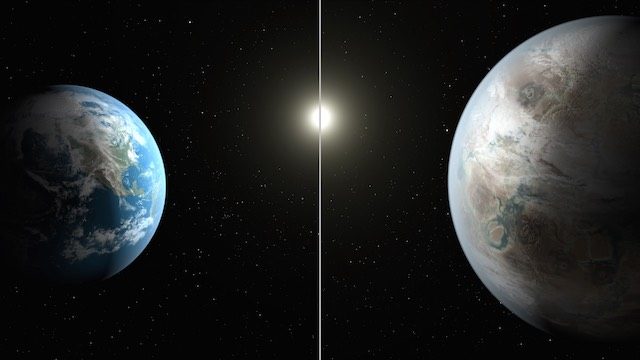SUMMARY
This is AI generated summarization, which may have errors. For context, always refer to the full article.

MANILA, Philippines (UPDATED) – Have we just found our home planet’s “cousin”?
Scientists on Thursday, July 23, announced the discovery of a planet some 1,400 light years away that has the same characteristics as Earth – and could shed light on what our planet could face in the future.
The object Kepler 452b has been confirmed as a planet by scientists from the NASA Kepler mission, and has been identified to be orbiting a star “very similar” to the Sun, at a distance similar to how our home planet orbits the Sun.
Kepler 452b is within its star’s “Goldilocks zone,” where it would be possible for liquid water to exist on the planet’s surface because it is not too cold nor too hot.
It is around 60% larger than the Earth, and has very high chance for it to be a rocky world, due to its location in its planetary system as well as its size. It is also estimated to be at least 5 times more massive than our home planet.
“This exciting result brings us one step closer to finding an Earth 2.0,” said John Grunsfeld, associate administrator of NASA’s Science Mission Directorate.
However, the star around which Kepler 452b is revolving is older than our Sun, the scientists said.
The star is 1.5 billion years older, and if the planet is “indeed a rocky planet, its location vis-a-vis its star could mean that it is just entering a runaway greenhouse phase of its climate history,” according to SETI Institute’s Doug Caldwell, part of the team working on the mission.
This means, the water on the planet’s surface could be heated considerably more and is evaporating – and the planet’s surface could be drying up.
“Kepler 452b could be experiencing now what the Earth will undergo more than a billion years from now, as the Sun ages and grows brighter,” Caldwell added.
Jon Jenkins, Kepler data analysis lead at NASA’s Ames Research Center, said that Kepler 452b can be thought of as Earth’s “older, bigger cousin… providing an opportunity to understand and reflect upon Earth’s evolving environment.”
More exoplanet candidates added to catalog

Kepler 452b is just one of more than 500 new exoplanet candidates recently identified by the Kepler mission, based on 4 years’ worth of data. This will be added to the current catalog of 4,175 candidates. Out of these, it is just one of 12 newly-identified exoplanet candidates that are somewhere between the size of Earth and Neptune, orbiting in their system’s habitable zone.
With this discovery, we are “one step closer to understanding how many habitable planets are out there,” said SETI Institute’s Joseph Twicken, who is also the mission’s lead scientific programmer.
“Continued investigation of the other candidates in this catalog and one final run of the Kepler science pipeline will help us find the smallest and coolest planets,” he said.
“Doing so will allow us to better gauge the prevalence of habitable worlds,” Twicken added.
The announcement was preceded by an intriguing teaser from NASA, saying: “The first exoplanet orbiting another star like our sun was discovered in 1995. Exoplanets, especially small Earth-size worlds, belonged within the realm of science fiction just 21 years ago. Today, and thousands of discoveries later, astronomers are on the cusp of finding something people have dreamed about for thousands of years – another Earth.”
NASA’s planet-hunting Kepler spacecraft was launched in 2009, and has so far scoured more than 150,000 stars for planets beyond our solar system.
More than 1,000 planets have been confirmed by the mission.
Astronomers can measure a distant planet’s age using a technique called asteroseismology, which measures the oscillations of the host star caused by sound waves trapped within it.
These waves lead to small pulses in the star’s brightness, which can be analyzed to measure its diameter, mass and age.
Scientists involved in the study also came from the NASA Ames Research Center, McDonald Observatory, the Harvard-Smithsonian Center for Astrophysics, the University of California, Berkeley, the NASA Exoplanet Science Institute, the University of California, Santa Cruz, and Penn State University. – With reports from Agence France-Presse/Rappler.com
Add a comment
How does this make you feel?
There are no comments yet. Add your comment to start the conversation.